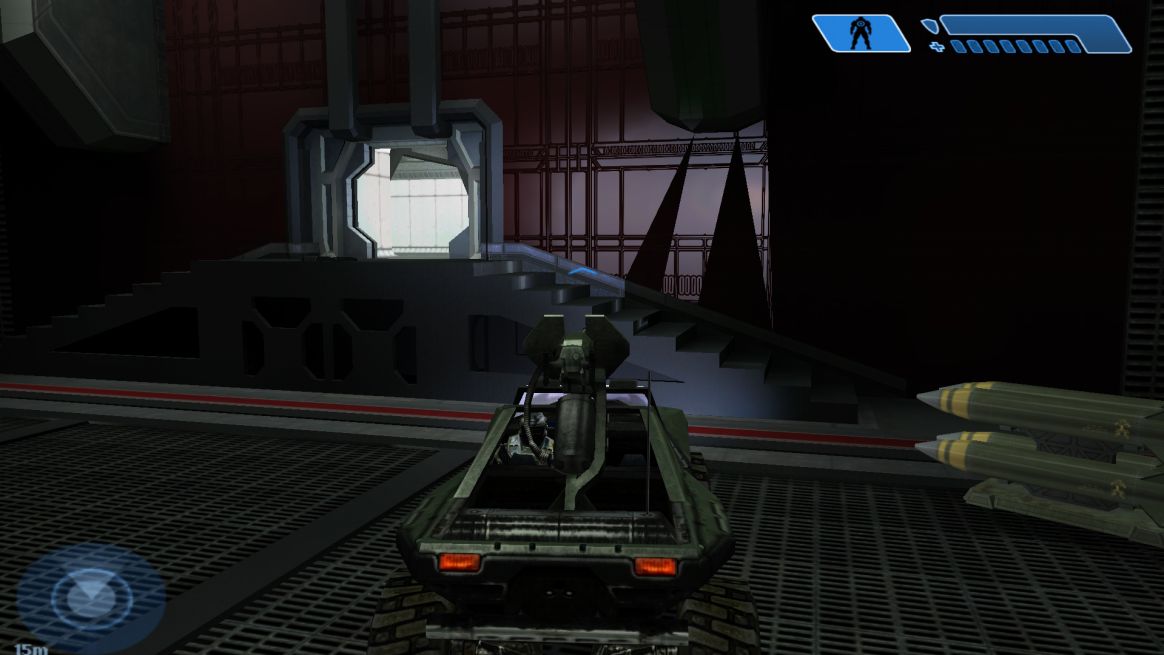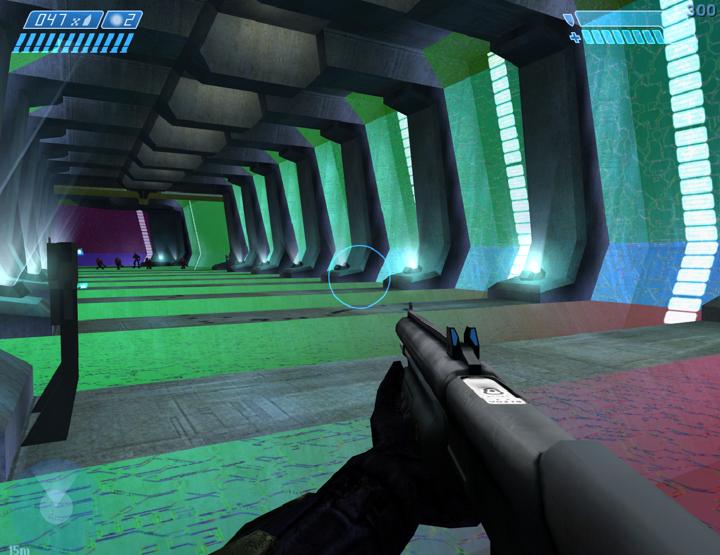
Using rasterizer_wireframe 1 demonstrates Halo's portal-based occlusion culling.
The renderer or rasterizer is the system of Halo's engine responsible for drawing the scene to the screen. Each ported edition of Halo has a slightly different renderer in terms of how well it reproduces the classic Xbox appearance.
Gearbox-era Halo uses the DirectX 9 API and shader version 2.0, being an early adopter of programmable shaders. Since support in user hardware was not as widespread as today, the renderer can be configured with arguments to use older shader versions or even fixed function compatibility.
Current versions of H1A use DirectX 11 instead.
Texture cache
Textures to be rendered are loaded in a texture cache in memory. When a texture must be drawn that is not in this cache, it will be loaded from a map cache file (possibly a shared resource map) or the tags directory depending on the build type of the engine. This is called a cache miss and, because it takes some time to stream data, the engine may not render the desired effect. This is the reason why weapons will sometimes not produce projectile decals on the first impact.
The predicted resources block seen in some tag classes are meant to give the engine a hint about what textures (and sounds) should be cached.
Lighting
Halo's lighting engine benefits from the fact that there is no dynamic time of day. Most dynamic lights are small. Similar to other games of the time, Halo uses "baked" global illumination in the form of lightmaps. This lighting information is used on the environment (BSP) and encodes localized light directions and tinting to shade objects.
Dynamic shadows for moving objects like units and items are rendered with 128x128 shadow maps at run-time. An object's bounding radius field, not its render bounding radius, is used to calculate the physical width of the shadow canvas. If the bounding radius is too small, the shadow will be cut off.
Limits

Dynamic lights cause parts of the BSP to be rendered in another pass, but only 4096 triangles per light. High-poly spaces may reach this limit.
Known renderer limits with the unmodified game are:
- Particle_
system particles: 256 - Non-particle system particles: 512
- Objects: 256 (raised to 512 in H1A)
- Maximum dynamic BSP triangles: 16k (raised to 32k in H1A) -- a BSP can have more triangles than this, but the rendered amount should be managed with portals.
- Lights: 128
- Surfaces per point light: 4096 -- limits how many triangles can be illuminated by a dynamic light (see figure)
- Surfaces per dynamic object shadow: 4096 -- limits how many triangles can be shaded by dynamic object shadows (Highly unlikely scenario)
There are also game state limits which can appear like renderer limitations (eg. maximum simulated antennas).
Some client mods like Chimera can raise limits. See mod-specific documentation for details.
At large distances from the origin (starting at approximately 1,000 world units), the effects of low 32-bit floating point precision become apparent in greater z-fighting and jittering of moving vertices from the inability to represent small distances. The game is hard-coded to prevent the camera from moving outside of a 10,000-world unit cube centered at the origin (5,000 units along any axis). Game mechanics and mesh rendering begin to break down around 1 million world units.
Gearbox regressions

The glass shader with bump-mapped reflections renders incorrectly in Custom Edition.
When Halo was ported to PC by Gearbox in 2003 many visual bugs were introduced. Among the challenges were updating H1X's shaders and rendering code to work with DirectX 9 and unlocked framerates in an engine which previously assumed 30 FPS always. The renderer also needed to be adapted for the range of user hardware for the PC port.
Most of these issues have now been corrected in DX11 renderer in MCC.
- H1X's shader_
transparent_ generic tags were converted to shader_ transparent_ chicago (or extended) tags which are less sophisticated. - The detail after reflection flag of shader_
model is working in reverse of how it should. Enabling the flag should cause detail maps to apply after specularity/cubemaps. The client mod Chimera has a built-in fix which is disabled for Halo Custom Edition (but enabled in Retail) except in the Vaporeon builds. - The reflections of projectile widgets like light_
volumes in mirrored surfaces are misaligned. Attachments like contrails are not affected, nor are vehicle widgets. This works correctly on Xbox and MCC only. - The fog screen layers effect for simulated volumetric fog does not render at all and fog planes do not render over the skybox.
- HUD shield meters are missing their flash effect when drained.
- Monochrome bitmaps and p8 bump map formats are unsupported.
- Custom Edition skips rendering some effects when they are not loaded yet, such as the engine lens flares in a10's intro or initial bullet hole decals. This is to prevent stuttering since some raw data must be loaded from map files if it is not already in the asset cache.
- Transparent shaders have a host of appearance and sorting problems:
- Ripple map mipmaps for shader_
transparent_ water are reversed, with smaller mipmaps being used at closer distances. MCC is not affected. - shader_
transparent_ glass which use bump maps use the wrong tag for cube map reflections in Custom Edition. They should use the shader's referenced cube map, but instead use the rasterizer vector normalization bitmap referenced by globals. - Transparent shaders do not sort properly behind shader_
transparent_ glass; they will shift in front and behind each other. Part indexes allow draw order to be set manually for objects through the gbxmodel, but there is no such method for the scenario_ structure_ bsp; the best you can do is flag the transparent shader to draw before water since glass shaders seem to render in the same stage as water. - shader_
transparent_ plasma (energy shields) does not render correctly on some hardware, and always incorrectly in MCC. - Environment decals using the double multiply blend mode, like those on the floor of the mission a10, do not render.
- Multiply is broken in shader transparent chicago/extended. The Refined mod had to recreate things like the inner shadow of the Halo ring and Cortana's pedestal shaders because it shows as invisible by default with multiply.
- Weather particles don't draw when near opaque fog. Suspected difference from Xbox but not confirmed.
- Atmospheric fog appears to have sorting issues with fog planes, and is even further compounded by shader_
transparent_ water sorting. The levels 343 Guilty Spark and Assault on the Control Room are most impacted by this. The water sorting issue is fixed in MCC. - Transparent shaders occasionally Z-fight with BSP geometry due to floating point precision.
- Ripple map mipmaps for shader_
- Many effects are still tied to frame rate rather than tick rate. Without using mods, and at high frame rates, these effects may break down or progress faster than intended.
- Camera shake in damage_
effect - Point generation of contrail
- The fading of radar blips
- Camera point animation (stops being smooth over 60 FPS)
- Camera shake in damage_
- shader_
environment is also heavily affected: - Using shader_
environment on gbxmodels does not function properly; specularity isn't masked, and atmospheric fog does not render correctly on such objects. This only affects Custom Edition. - Self-illumination animation has inconsistent behavior. Plasma animation does not scale or loop properly on some hardware (working in MCC).
- The bumped cubemap reflection type does not tint cubemaps. Perpendicular and parallel brightness do not take angle into account.
- Some specular lighting may be missing, which makes dynamic lights appear smaller in radius (e.g. flashlight).
- Bump map shadows are only visible when dynamic lights are nearby, but should be visible at all times using lightmap data for light direction and tint.
- The "normal" type may incorrectly mask primary and secondary detail maps when an alpha is present in the base map, visible in b40 exterior tech wall.
- Using shader_
H1A regressions
Althoug the H1A MCC renderer is much improved over the original Gearbox port to PC, some new issues exist:
- Detail objects with the screen facing type do not render. This affects the fungal pods in c10.
Troubleshooting
Some PC hardware configurations may cause problems with the renderer, specifically transparent shaders stretching/exploding, and mirror reflections exploding. If you are experiencing this, try forcing 1 core affinity for the game process.
Acknowledgements
Thanks to the following individuals for their research or contributions to this topic:
- Conscars (Extreme distance limits and detail objects testing)
- gbMichelle (Researching how shadow maps work, extreme distance and particle limits testing)
- Jakey (Renderer regressions)